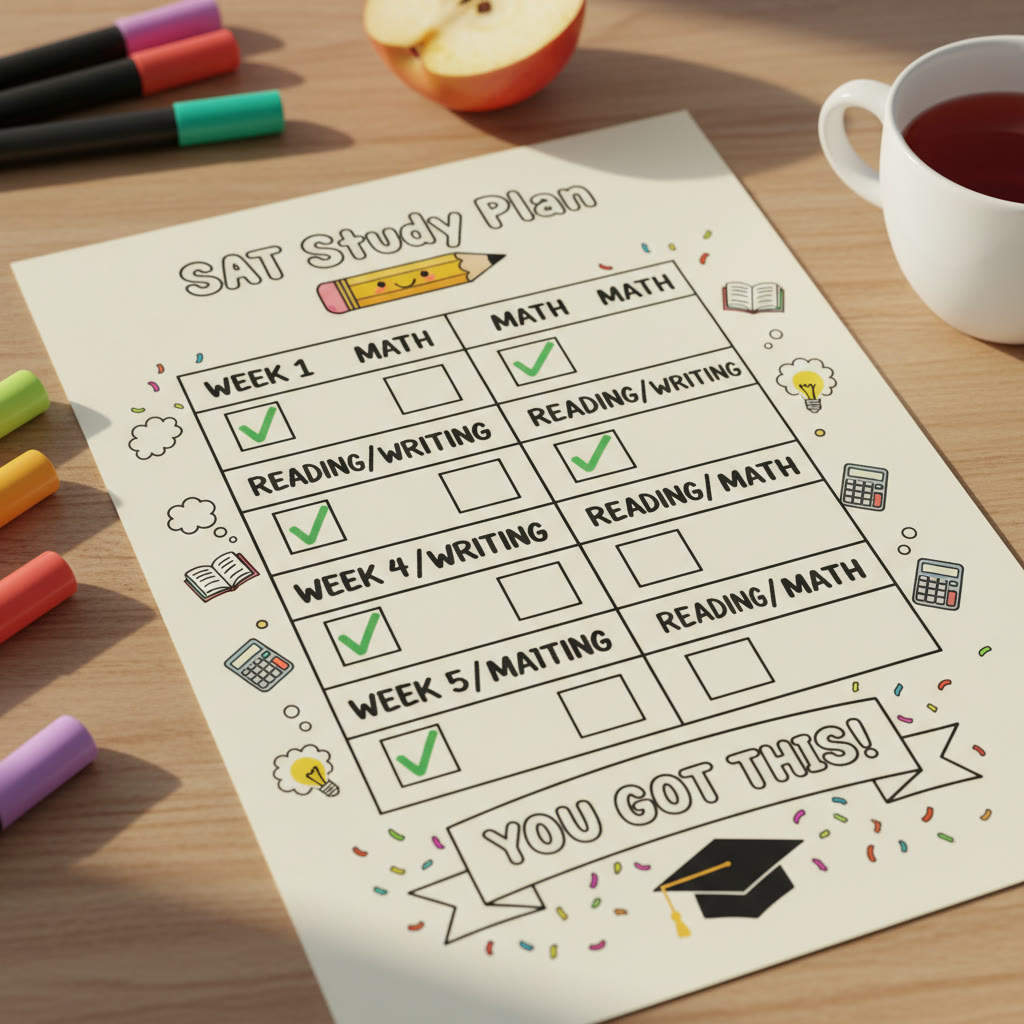Why the Order of SAT Sections Matters More Than You Think
When you picture the SAT, you probably imagine a quiet room, a stack of test booklets, and 180 or so minutes of concentration. What many students overlook is that the sequence in which sections appear can quietly change how well they perform. This is not mystical. It is a mix of psychology, physiology, and simple test-taking logistics. Understanding that mix gives you an edge you can practice into lasting improvement.
What we mean by section order
Section order refers to the sequence in which a student tackles Reading, Writing and Language, and Math on the SAT. Depending on whether you are practicing with paper tests, the digital SAT, or an adaptive module, the exact format can vary. But the core idea is universal: the task you face first, second, and last shapes the state of mind you bring to each question.
Four ways section order changes performance
At a high level, the order influences you by affecting attention, fatigue, confidence, and strategy. Each of these plays a big role in the kind of answers you produce under timed pressure.
1. Attention and warm up
Our brains do not jump instantly to peak performance. There is a warm-up curve. When you begin with a dense reading passage, you are asking your attention system to ramp up into heavy comprehension right away. If you start with a math section instead, you might warm up with procedural thinking and then face comprehension when attention may be slightly taxed. Starting with a student s strongest skill can build momentum; starting with the hardest section before you are warmed up can make early mistakes cascade into stress.
2. Cognitive fatigue and stamina
Cognitive resources like working memory and sustained attention are finite over long tasks. The sections you do later in the test will be influenced by accumulated fatigue. For example, if a student has already wrestled with dense reading passages for 65 minutes, their performance on later math problems that require careful multi-step reasoning may dip because they have less mental stamina available.
3. Switching costs and mindset
Switching from narrative interpretation to grammar editing to algebra is not instant. Each shift requires a small reconfiguration of how you read questions and what you search for. These switching costs matter more when the two sections have very different thinking styles. If you are forced to jump back and forth in practice, you might feel slow for the first few questions in each new mode.
4. Anxiety and momentum
Performance is emotional as well as logical. Small successes early on create confidence, which reduces anxiety and frees up mental resources. Conversely, hitting a wall in the opening section can raise stress and make a student second-guess easy questions later. Strategic ordering or upfront planning can build the kind of momentum that helps maintain clarity throughout the test.
Real student scenarios: how order shifts outcomes
Let s look at short, realistic stories to see the principles in motion.
Maya: The Reader First
Maya is strongest in reading. She practices with Reading first and uses that success to settle her nerves. By the time she hits math, she is calm and focused, which helps her tackle multi-step problems carefully. The only pitfall is fatigue in the final math calculator section, so she practices pacing to keep energy in reserve.
Jordan: The Math Waker
Jordan finds math faster and more energizing first thing. He opens the test with math sections to push his score higher early and then moves to reading when he s warmed up. The risk is decreased reading comprehension late in the test. Jordan counters this by practicing longer reading sets under fatigue so his late-test focus improves.
Casey: The Mixed Approach
Casey alternates strategies during practice: some days starting with reading, others with math. This exposes Casey to switching costs and reduces surprises on test day. That flexibility paid off when Casey took the digital SAT and encountered a different sequencing rhythm than expected. Having practiced both patterns, Casey adapted quickly and kept calm.
Practice wisely: What to simulate and why
You cannot change the official order on test day, but you can change how you prepare. Practice is where section order stops being a guess and becomes a mastered skill.
Three recommended practice protocols
- Fixed-order practice: Practice the sections in the official or most likely test order to master pacing and warm-up for that sequence.
- Reverse-order practice: Take the test in reverse order occasionally to build stamina for later sections and reduce late-test dips.
- Mixed-order stress tests: Simulate unexpected sequences and shorter recovery windows to train adaptability under surprise.
A disciplined mix of these approaches prepares you for both the expected and the unexpected, so test day feels familiar no matter how the sections arrive.
How to choose the right order for you
Use a data-guided approach. Start with honest diagnostics, then design practice that targets weak spots while protecting strengths.
Step 1. Diagnose with mini-tests
Set aside four timed mini-sections and take them in different orders on different days. Track accuracy, timing, and how you feel mentally after each mini-test. Keep a log of which section order left you exhausted and which left you confident.
Step 2. Analyze patterns
Look for consistent drops in accuracy after certain sections. Do long reading passages always sap your energy for math? Or does a quick math warm-up sharpen your focus for grammar? These patterns tell you where targeted endurance work or pacing adjustments are needed.
Step 3. Build a tailored practice plan
Design practice blocks that mimic your best path while shoring up weaknesses. If you do better after starting with math, practice keeping enough energy to maintain reading accuracy. If you must start with reading, include short mental warm-ups that get you into a comprehension mindset faster.
Concrete strategies to control order effects on test day
Here are practical tools you can apply immediately, both while practicing and on the actual SAT day.
Pacing with micro-routines
After every passage or problem set, perform a 5 to 10 second micro-routine. Take a slow breath, check your pacing, and note whether to speed up or slow down. These tiny resets reduce drift in attention caused by section transitions.
Frontloading confidence
If you can choose which questions to tackle within a section, open with a handful of easier items to build momentum. This is different from skipping strategically; it s about earning quick, reliable wins that quiet anxiety without wasting time.
Stamina training
Stamina is a muscle. Strengthen it by practicing full-length tests in different orders, including some where you schedule a mini-break between sections to simulate mental recovery. Over weeks, that deliberate fatigue training increases your ability to sustain focus late into the test.
Table: Practical comparison of ordering strategies
The table below illustrates typical trade-offs when choosing an opening section combined with training focus. Data here is illustrative to guide decision making, not a guarantee of results.
| Starting Section | Typical Advantage | Common Drawback | Training Focus |
|---|---|---|---|
| Reading | Builds early comprehension momentum and calms nerves | May cause fatigue for later math reasoning | Endurance for late math, quick warm-ups for algebra |
| Writing and Language | Quick confidence boosts from smaller, objective questions | Less time to ramp up for dense reading or tricky math | Practice long reading under fatigue, rapid grammar drills |
| Math First | Harnesses fresh analytical energy and reduces careless slips | Reading may suffer later if stamina is low | Comprehension under fatigue, mixed sections practice |
What the digital SAT adds to the order conversation
The newer digital SAT model changes the rhythm of the exam. It often uses shorter modules and adaptive item selection. That means the way you sequence tasks and recover between modules matters even more. If the test adapts and rewards early accuracy, a strong opening on your best section becomes doubly important. On the other hand, adaptive formats also reward consistent performance across modules, so avoiding big late-test drops is crucial.
Adapting your practice for digital format
- Practice in shorter, focused modules to mirror the digital pacing.
- Track accuracy per module to see where performance dips.
- Train for quick context switches so you reconfigure your thinking fast between module types.
How Sparkl s personalized tutoring can help
Designing an effective plan around section order is an individual puzzle. Sparkl s personalized tutoring supports students through one-on-one guidance, tailored study plans, expert tutors, and AI-driven insights that identify your order-related vulnerabilities. Instead of guessing whether you should start with math or reading, Sparkl helps you test both strategies in a controlled way, analyzes the results, and builds a practice plan that reflects your learning profile and target score.
What Sparkl brings that is unique for this challenge is the combination of human coaching and intelligent feedback. An expert tutor can observe small habits, like how quickly your focus drops after a long passage, while AI-driven analytics reveal trends across multiple practice tests. Together they create a loop of practice, analysis, and adjustment that directly targets the order-related weaknesses you uncover.
Sample 6-week practice plan focused on order
Below is an example plan you can adapt. The aim is to test, build stamina, and then fine-tune the order you will use on test day.
- Weeks 1 2: Diagnostic and baseline
- Take two full-length practice tests, one in standard order and one in reverse order.
- Log accuracy, timing, and fatigue points.
- Weeks 3 4: Targeted endurance and skills
- Alternate daily practice: long reading sets on Monday, math endurance on Tuesday, mixed sets on Wednesday.
- Include 2 simulated full-length tests with different orders each weekend.
- Week 5: Strategy refinement
- Decide on a preferred order strategy informed by data.
- Practice micro-routines and warm-up rituals for test day.
- Week 6: Taper and rehearsal
- Two full simulations in preferred order with full test-day conditions.
- Light practice days focused on mental recovery, not heavy drilling.
Practical tips for test day based on order principles
- Start with a short, consistent warm-up before you open the booklet. A 60 second focused breath and a quick note about pacing can settle attention.
- Use micro-routines between passages to reset and reduce switching costs.
- Frontload a couple of quick wins when starting a section to build confidence.
- If you feel fatigue creeping in, slow down for one minute to re-orient rather than letting small errors snowball.
- Trust the practice you did in different orders. Flexibility is your friend if something unexpected appears on test day.
Final thoughts: Make section order work for you
Section order is not destiny. It s a lever. With thoughtful diagnostics, disciplined practice, and a few tactical habits on test day, you can neutralize weaknesses and accentuate strengths. Whether you need to build late-test stamina, sharpen your warm-up, or learn to switch gears quickly, practice that mirrors test reality is the fastest path to improvement.
If you want help turning diagnostics into a tailored plan, Sparkl s personalized tutoring combines human expertise with data-driven insights to craft study plans that respect how section order affects your performance. One-on-one guidance, targeted drills, and AI-backed analysis can save you weeks of random practice and turn small adjustments into measurable gains.


Remember: the SAT is a skills test and a stamina test. The order of sections nudges both skill and stamina in subtle ways. Study smart, practice deliberately, and use the right support when you need it. That is how you turn a small strategic advantage into a real score increase.












No Comments
Leave a comment Cancel